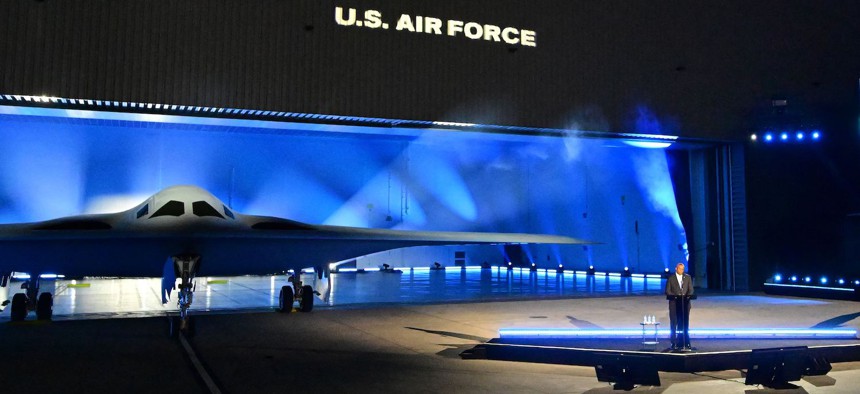
US Secretary of Defense Lloyd Austin speaks at the B-21 Raider unveiling ceremony at Northrop Grumman's Air Force Plant 42 in Palmdale, California, December 2, 2022. AFP via Getty Images / FREDERIC J. BROWN
Defense Business Brief: Behind the scenes at B-21 unveiling; Reagan Forum recap; Exec leaves Boeing; and more.
Getting into U.S. Air Force Plant 42 in Palmdale, California, is kind of like visiting a prison. Even beyond the security checkpoints and barbed wire fences, there are still many more layers of protection for the secretive military technology inside the hangars at the sprawling desert complex.
On Friday night, government officials, lawmakers, and a small group of reporters were allowed inside Northrop Grumman’s Site 4 compound to see the top-secret B-21 stealth bomber for the first time.
Upon arriving, mobile phones and other electronics were taken and locked up for safe keeping. Everyone had to pass through metal detectors. Cameras without zoom lenses were allowed, but photographers needed to remain on a pre-positioned platform flanked by rows of seating. The invite-only guests at the seven-years-in-the-making event had to register weeks in advance.
But the unveiling of a top-secret plane doesn’t happen every day; it’s been three decades since the B-2 stealth bomber was unveiled at the same facility.
Here are some new things we learned about the B-21, as well as some behind the scenes of what happened on Friday night:
It’s not the first time the B-21 has been outside. An official picture provided by the U.S. Air Force shows the aircraft parked on the ramp next to the hangar it was pulled out from on Friday night. Plus, it had to be moved from the assembly line in what’s known as Building 401 at the Northrop Grumman compound to the single-aircraft hangar used during the ceremony.
Side note: The center fuselage for the F-35 stealth fighter is built on a different assembly line inside the same building before being shipped to a Lockheed Martin assembly line in Fort Worth, Texas.
The B-21 that was parked and eventually pulled out of hangar 423 was covered with a custom-fit, pleated sheet. Before the hangar doors slid open, fog machines pumped smoke inside, creating a haze that was pierced with laser light during the ceremony.
Many people questioned why the unveiling was held so late in the evening. The timing could have been for ambiance—after all, the lighting set the mood—but it also could have been to hide from overhead satellites. That official picture of the B-21 outside also appears to have been taken at night (the telltale sign: red warning lights on the hangar).
When the plane was finally pulled outside of the hangar, no one was allowed to see it from behind, likely due to the design of its engine outlets. Since sensors can spot heat signatures, the design likely does something to mask it from detection. Several people in attendance also questioned whether there were any intentional changes made to obscure or protect sensitive designs or technology during the rollout.
Lots of VIPs were in attendance. Among them, former Air Force Secretary Heather Wilson, CEOs of B-21 suppliers, and former Northrop CEOs, including Wes Bush and Ronald Sugar.
Shortly before the ceremony began, a small single-engine prop plane flew over, just north of the airfield. It’s unclear who was flying.
Welcome
You’ve reached the Defense Business Brief by Marcus Weisgerber. Send along your tips and feedback to mweisgerber@defenseone.com or @MarcusReports. Check out the Defense Business Brief archive here, and tell your friends to subscribe!
The Reagan National Defense Forum was back in full effect with its typical who’s who list of participants from the Pentagon, Congress, and defense industry. Organizers and speakers have long billed the event, attended by lawmakers from both sides of the aisle, as a bipartisan forum.
What was everyone talking about:
- The 2023 National Defense Authorization Act. Lawmakers and defense officials all stressed the need to pass the year-long defense appropriations bill quickly, as the current continuing resolution expires next Friday. Congress could vote as soon as this week;
- China’s military advancements and Russia’s invasion of Ukraine;
- The desire for multi-year contracts, especially for munitions; and
- The continued need to embrace startups and commercial tech.
Heidi Shyu, the undersecretary of defense for research and engineering, referenced the B-21 rollout and then said: “There’s a lot of stuff in development that has significantly more capabilities,” leading me to exclaim on Twitter: What is it?!
Seeing all of those gigantic Northrop, Boeing, and Lockheed Martin hangers at Plant 42 in Palmdale really makes you wonder what’s happening inside all of them.
For one, the Next-Generation Air Dominance, or NGAD, which is being billed as the first sixth-generation fighter jet, is being developed secretly. Now that the B-21 has been revealed, a stealthy companion would be fitting.
Who we spotted: In addition to the long list of current government officials, Ellen Lord, David Norquist, Raj Shah, Eric Fanning, Jamie Morin, Palmer Luckey, Dave Goldfein, Paul Selva, Joseph Votel, Heather Wilson, Brett Lambert, Mike Holmes, and Jonathan Hoffman.
We’ll have more stories from Reagan throughout the week.
Finally, Mark Cherry, who ran Boeing’s rotorcraft programs, has left the company, according to people familiar with his departure. Boeing removed Cherry’s biography page from its website in recent days. Cherry ran Boeing’s development division Phantom Works and was previously the president of and COO of Aurora Flight Sciences, which Boeing acquired in 2017.




